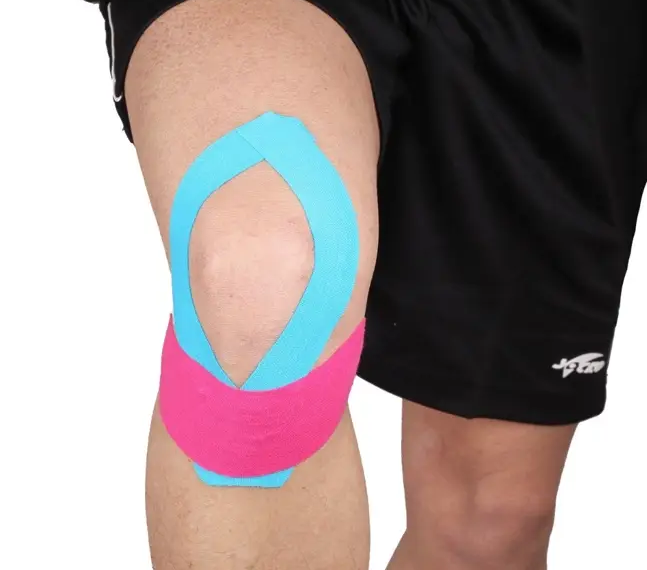According to the Academic Academy of Orthopedic Surgeons, there is an estimated 10 million cases of knee complaints at clinics annually in the USA.
Therefore, without question, knee injuries are a common phenomenon. More times than not, these injuries are relatively minor and hardly require major treatment procedures.
However, they usually require some support and management before and during recovery. Knee strapping is a major procedure that suffices in this respect. This article discusses the intricacies of knee strapping and answers the question of the best tape for the process, among other subjects.
Different Methods of Knee Strapping
Knee strapping methods are primarily defined by the type of tape used in the process and the goal in mind — pain reduction or sturdy support. The two major types used are athletic tapes and Kinesio tapes.
Athletic tapes are a special kind used in sports and physical therapy and are typically made from cotton, latex, or synthetic fiber. These tapes are typically inelastic and possess remarkable adhesiveness. These properties make them adept at supporting and stabilizing ailing joints and muscles by holding them firmly. In other words, they restrict movement as they provide support. An example is the Hampton Adams 3 Pack White Athletic Sports Tape.
On the other hand, Kinesio tapes are a relatively more elastic type of tape that also offer support to ailing or injured tissues. However, unlike athletic tape, these tapes do not impede motion, nor are they restrictive in their action. They allow for flexibility of movements as they support these tissues during recovery. The Hampton Adams 2 inches × 16ft Kinesiology Tape and 2 inches × 135 Feet Bulk Kinesiology Tape are some premium examples of these tapes.
Athletic Tape vs. Kinesio Tapes: Which Is Better for Knee Strapping?
The increasing preponderance of taping in physical therapy and sports has inadvertently fostered a comparison between the two major taping methods. The question of the “better option” between Athletic and Kinesio tapes crosses the minds of many sports enthusiasts and members of other demographics at some point — and will continue to do so.
Nonetheless, which really is the better option in general – and particularly for knee strapping?
The short answer is none, really. It is not that simple. The long answer, on the hand, is that the question of the better option (or choice) per person boils down to many factors. These factors include the prevailing circumstances before use, the intended purpose of use, economic constraints, the intended duration of use, and the personal preferences of the person involved, among other reasons.
Athletic tapes are generally the go-to option if you seek sturdy support and stability of body parts. Since they are made of tough, inelastic material, they often more than suffice in this respect. In the case of the knee joint, they immobilize the joint and restrict movements that could exacerbate the injury or impede recovery. Kinesiology sports tapes, on the other hand, while providing some degree of support, are generally the go-to option if you seek some more flexibility. These tapes are designed to act like human skin and cause a less powerful grip force on the skin. For better circulation at the site of injury, reduction of inflammation, and improved functions or pain alleviation, Kinesio tapes are also the better option.
Therefore, this implies that athletic tapes are easily the better choice in situations where maintaining joint stability — even at the expense of immobilization — takes pre-eminence, such as a severe knee sprain. On the other hand, a person who would like to remain active while steadily nursing an injury to recovery is more likely to opt for a Kinesio tape for knee strapping ahead of athletic tape. This is because of the lack of restriction Kinesio tapes offer. These tapes keep your joints and muscles relatively inactive till you take them off.
Duration of use may also significantly affect choice. Because they are less tight on the skin, Kinesio tapes can notably last for long periods at a stretch. Hampton Adams 2 inches × 16ft Kinesiology Tape and 2 inches × 135 Feet Bulk Kinesiology Tape, for example, can last about 3-10 days after application. On the other hand, athletic tapes can only last for a few hours at a time to a day or two, at maximum. Any longer, and they could disrupt circulation and cause pain, discomfort, or tissue damage. Therefore, a person seeking to support his knee for long periods at a stretch will most likely opt for a Kinesio tape ahead of an athletic tape.
Economic and financial constraints could also sway one’s go-to option for injury management. Although prices vary with brands, locations, and seasons, athletic tapes are generally cheaper than Kinesio tapes. The former is usually found at different outlets at lower prices, while the latter is relatively expensive due to its design. Kinesio tapes are also generally sold in smaller quantities. This suggests that a person seeking a cost-effective management plan for their knee is likelier to stick with athletic tapes instead of Kinesio tapes.
How to Apply Kinesio Tape for Knee Strapping?
Here is a simplified version of applying Kinesio tape to the knee:
- Before you start, you should clean the area around the intended application site with alcohol or with soap and water. This is because dirt could get in the way of proper adhesion. You should also ensure that you apply these tapes before engaging in physical activity.
- Sit with your knee slightly bent, usually around 90°. This helps to orient and relax the muscles around the knee properly for a good, result-yielding application.
- Cut off a half strip of tape. Remove the adhesive paper backing at the middle of the tape and lay it just below the knee cap. Remove the rest of the protective layer on the adhesive and rub down the tape for optimal effects. All the while, ensure the tape is stretched at 80% tension and lay down the ends at 0% tension.
- Pull another half strip of tape and apply it exactly as the first. However, ensure that it slightly overlaps the previously laid tape.
- Pull out a full strip and remove the covering on the adhesive at the edge. Anchor at the inner side of the quadriceps femoris — the fleshy mass of anterior thigh muscle. After anchorage, pull down the other end at a low stretch, down the edge of the kneecap’s margin, and anchor the last few inches below the kneecap with no stretch.
- Repeat the process on the other side of the knee and rub down the tapes to enhance their adhesion.
How to Apply Athletic Tape for Knee Strapping
Below is a simplified version of how to apply tape to support the lateral ligament when injured. This ligament is not usually as sprained as the medial collateral ligament but is at risk nonetheless.
- First, you must apply these tapes before engaging in physical activity — for about an hour at least.
You should also use alcohol, soap, and water to clean the area around the knee, as dirt could prevent effective adhesion.
- Next, you could apply a pre-wrap over your knee surface.
Pre-wrap lies between your skin and the tape; thus, it usually helps protect your skin. Ideally, the width of your gauze should be more than that of your tape.
- Next, tear a sizeable amount of tape and wind it around the lower part of your thigh, just above the upper tip of the kneecap. After a full wind around the thigh, cut off and anchor it firmly. This serves as a fixator.
- Next, wind another sizeable amount of tape around the upper leg. The first anchoring to the tape should be oriented to cross over the “head of the fibula” and the top of the calf. After a full wind, anchor the other end at the anterior part of the leg. This serves as another fixator of sorts.
- After this, cut another strip of tape and stretch it diagonally across the two “fixators” on the lateral part of the leg. Cut another and stretch it over and across the two transversely applied tapes such that it crisscrosses the previous strip. Rub them down for proper adhesion.
- Finally, apply tape over the ends of the straight strips of tape such that it runs over the two “fixators” — the two transversely applied pieces of tape above and below the kneecap.
Hampton Adams Tapes
Whether it be sturdiness or flexibility that you seek to manage your knee injury, Hampton Adams has you covered. The Hampton Adams 2inches × 16ft Kinesiology Tape and 2 inches × 135 inches Bulk Kinesiology Tape are premium kinesiology tape products designed for optimal use, thanks to their durability, quality, and favorable consumer policies. The Hampton Adams 3 Pack White Athletic Sports Tape is, on the other hand, a leading brand of athletic tape recommended by reputable medical practitioners and sportspersons alike. If you want to kick-start the ultimate tape journey, visit the Hampton Adams website today to browse the catalog and place an order!







